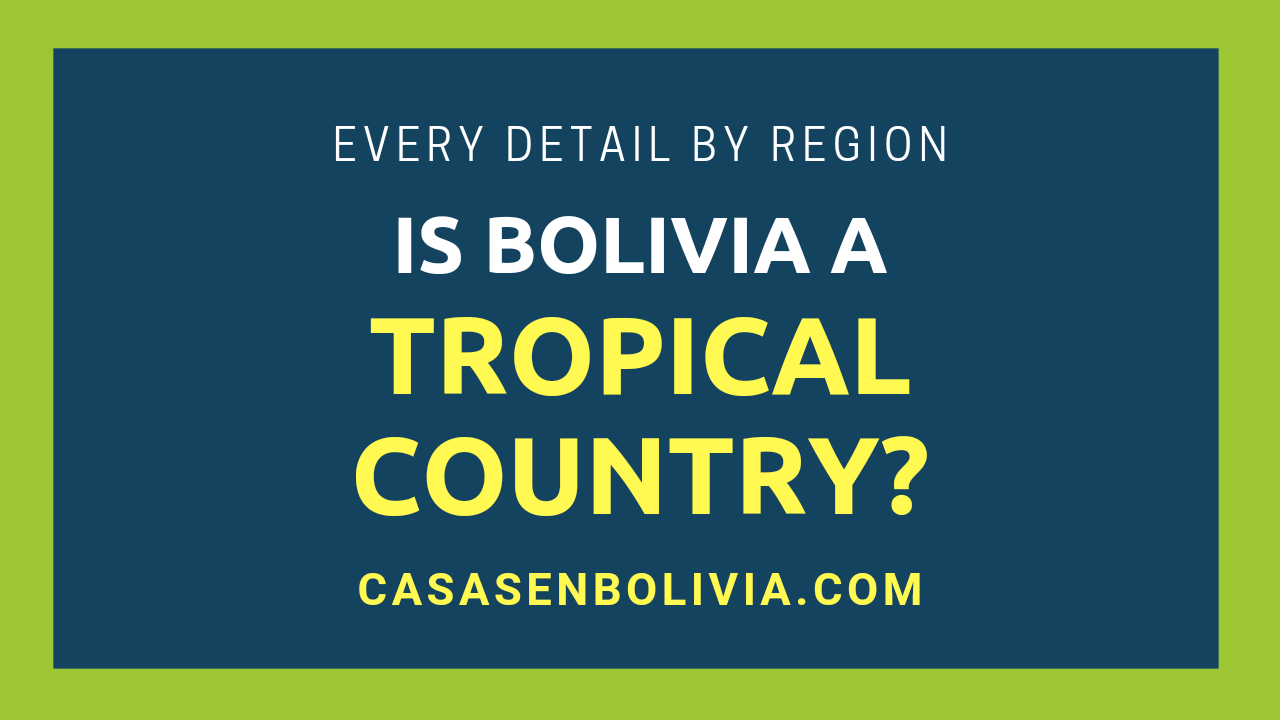Last Updated on February 15, 2025
Many people from other countries mistakenly believe that Bolivia is solely an Altiplanic (high plateau) region. In reality, Bolivia has three distinct climates and geographical regions, with the tropical climate and geography being the most extensive.
Bolivia is, in fact, predominantly a tropical country. Around 45% of its territory is tropical land, with a significant portion belonging to the Amazon region in the north. Furthermore, most of Bolivia’s population lives in tropical areas, and its largest city, Santa Cruz de la Sierra, is also tropical.
As Bolivian citizens who have spent our entire lives in this country, we’ll provide you with all the details regarding whether Bolivia is truly a tropical country. We’ll also discuss the main cities and tourist destinations that are located in tropical regions.
Yes, Bolivia is Predominantly a Tropical Country
The Andes Mountains cross Bolivia from north to south, dividing the country’s territory into three distinct climatic and geographic regions:
- The Altiplanic East (which is very cold and alpine).
- The central mountain range corridor (which has a temperate climate, is rugged, and divides the country from north to south).
- The tropical West (which is a vast, flat tropical expanse that extends eastward and reaches the Amazon).
This means that approximately 45% of Bolivia’s total territory is tropical. This area is concentrated in the eastern part of the country, as well as in the far north and southeast.
The eastern, part of the northern, and part of the southern regions of Bolivia are tropical. These areas are adjacent to or within the Amazon, consisting of a vast, endless plain covered by dense jungle, with consistently hot temperatures, high rainfall, and predominantly humid air. Most of Bolivia’s population resides in this tropical region.
You can visualize Bolivia as an analog clock, where the area from 11:00 to 5:00 is tropical, the corridor running from 10:00 straight to 6:00 represents the Andes Mountains, and the area from 7:00 to 9:00 is Altiplanic. The center is primarily an equal mix of Altiplanic land, mountain ranges, and tropical land.
Bolivia’s Tropical Regions
The parts of the country with a tropical climate and Amazonian geography are:
- Part of the northwest of the country (featuring flatlands and some hills with tropical climates).
- The far north of the country (actually within the Amazon, it’s a tropical Amazonian landscape).
- The northeast of the country (also within the Amazon, entirely flat and very marshy).
- The east of the country (adjacent to the Amazon, with slightly cooler temperatures but still a tropical climate).
- The southeast of the country (very flat and humid, with a standard tropical climate).
- Part of the south of the country (with a subtropical, cooler, and drier climate due to its proximity to the South Pole).
Now, let’s look at the departments and principal cities of Bolivia located in this tropical part of the country:
- Santa Cruz Department
- Contains Santa Cruz de la Sierra City (population 1,500,000, situated on tropical flatland).
- Is Bolivia’s largest department, located in the east.
- 80% of this department is tropical.
- Beni Department
- Contains Trinidad City (population 150,000, located in marshy Amazonian terrain).
- Is also very large, located in the northeast.
- 100% of this department is tropical.
- Pando Department
- Contains Cobija City (population 60,000, located in Amazonian territory).
- Is relatively small, located in the north.
- 100% of this department is tropical.
Areas of Bolivia That Are Not Tropical
The parts of the country that are not tropical and have other types of climates and geography are:
- Part of the northwest of the country (containing rugged valleys and the Andes Mountains).
- The west of the country (containing the Altiplanic, a high-elevation plateau *for which Bolivia is best known*).
- The southwest of the country (also containing a vast Altiplanic plateau).
- Part of the south of the country (containing the Andes Mountains, numerous valleys and hills, and the very hot and dry Gran Chaco desert).
- The center of the country (containing the Andes Mountains and numerous temperate valleys and hills).
Now, let’s examine the departments and principal cities of Bolivia located in these non-tropical parts of the country:
- La Paz Department
- Contains La Paz City (population 800,000, located in an Altiplanic region).
- Contains El Alto City (population 700,000, located in an Altiplanic region).
- A medium-sized department, located in the east.
- 30% of this department is tropical (*in its far north*).
- Cochabamba Department
- Contains Cochabamba City (population 650,000, located in a temperate valley).
- A small department, located in the center.
- 35% of this department is tropical (*in the northeast*).
- Oruro Department
- Contains Oruro City (population 400,000, located on cold Altiplanic land).
- A small department, located in the east.
- 0% of this department is tropical.
- Potosí Department
- Contains Potosí City (population 200,000, located in cold, rugged Altiplanic terrain).
- A medium-sized department, located in the southeast.
- 0% of this department is tropical.
- Chuquisaca Department
- Contains Sucre City (population 400,000, located in a temperate valley).
- A small department, located in the center.
- 10% of this department is tropical (*in the east*).
- Tarija Department
- Contains Tarija City (population 350,000, located in a temperate valley).
- A small department, located in the far south.
- 15% of this department is tropical (*in the east*).
Tropical Cities: Santa Cruz de la Sierra, Trinidad, and Cobija
As you can see in the previous section, the three main cities of Bolivia are within tropical areas.
The largest city in the country, Santa Cruz de la Sierra, is situated on tropical flatland, but this city has a slightly cooler and drier climate than the other two cities.
Trinidad, the capital of the Beni department, is located in very hot, tropical, and swampy terrain near the Amazon.
Finally, Cobija, the capital of the Pando department, is located directly within the Amazon territory, with a fully tropical climate.
In summary, three cities are located in tropical areas and climates in Bolivia: 1) Santa Cruz de la Sierra, 2) Trinidad, and 3) Cobija.
Other Important Places in Bolivia’s Tropical Regions
Certain tourist destinations in Bolivia, located within the country’s tropical areas, are frequently visited by foreigners. We’ll discuss these places now.
Madidi National Park
This park is located in the La Paz department and features both temperate climates in rugged hills and mountains *and a very tropical climate in its northern region*, on flatland covered with dense jungle and experiencing high humidity most of the year. Many tourists visit this park for its biodiversity in both flora and fauna and the opportunity to encounter numerous exotic species.
The Chiquitania
Within this region lies the town of San Jorge de Chiquitos. It’s a historical town dating back to the Jesuit expeditions that attempted to convert native populations to Catholicism centuries ago in this vast area. Chiquitania has a tropical climate, but it’s significantly drier than other parts of the Santa Cruz department. The primary difference is that there is less precipitation than in other nearby tropical areas.
Rurrenabaque
One of Bolivia’s most visited destinations, this town is located in the Beni department and is very close to the Amazon, *resulting in a very tropical, humid, and marshy climate and terrain*. It’s also near the last remnants of the Andes Mountains, so it experiences slightly cooler temperatures during parts of the year.
Remember to take all necessary precautions in a tropical Amazonian climate like this, as these tourist destinations carry a high risk of contracting Malaria, Yellow Fever, Zika, and other endemic illnesses. Also, “Chagas Disease” is present in this area, so take all precautions against this very dangerous illness.
Conclusions:
In this article about whether Bolivia is a tropical country, you’ve seen that it indeed is. Approximately 45% of the total territory is fully tropical, and this area encompasses the north, east, and parts of the west, south, and center of the country.
You’ve also seen that three major cities are located within Bolivian tropical lands: Santa Cruz de la Sierra, which is Bolivia’s largest city; Trinidad, the capital of the Beni department; and Cobija, the capital of the Pando department. You’ve also learned that significant tourist destinations like Madidi National Park, Chiquitania, and Rurrenabaque are in tropical areas of the country.
You now know that Bolivia is predominantly a tropical country, contrary to what many people overseas believe. Furthermore, the majority of the Bolivian population resides in this tropical region.
We hope this information has been helpful. If you’d like to learn every detail about the climate in Bolivia, including the principal tropical cities as well as the Altiplanic cities, please visit our definitive guide here: How is the climate in Bolivia? A complete overview.
CasasenBolivia.com, information on living, working, investing, and traveling in Bolivia.








